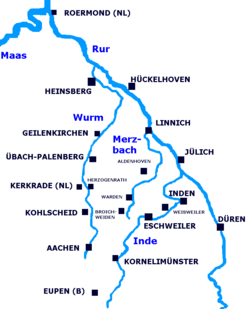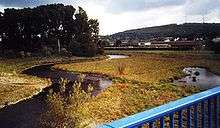Inde
| Inde | |
|---|---|
 Inde in Aachen-Kornelimünster | |
 Map of the Rur Basin, including the Inde | |
| Native name | L'Inde |
| Country | Germany, Belgium |
| Physical characteristics | |
| Main source |
Hautes Fagnes ±400 m (1,300 ft) |
| River mouth |
Rur 50°53′58″N 6°21′46″E / 50.89944°N 6.36278°ECoordinates: 50°53′58″N 6°21′46″E / 50.89944°N 6.36278°E |
| Length | 54.1 km (33.6 mi) [1] |
| Basin features | |
| Progression | Rur→ Meuse→ North Sea |
| Basin size | 374 km2 (144 sq mi) [1] |
The Inde (French: L'Inde) is a small river in Belgium, and in North Rhine-Westphalia, western Germany.
Geography

The Inde is a left (western) tributary of the Rur/Roer, in eastern Belgium and in North Rhine-Westphalia, western Germany.
Its source is near Raeren, in Eastern Belgium. The Inde runs through Aachen-Kornelimünster, Eschweiler, and Inden. Its mouth is on the Rur near Jülich. Because of lignite opencast mining, a section of the course was diverted near Inden-Lamersdorf in 2003 .
Tributaries of the Inde include the streams: Omerbach, Otterbach, Saubach, Vichtbach, and Wehebach.

History
Its name is of Celtic origin: Inda. The Inde has a counterpart, a "small Inde", in France: the Andelle, which is a 55-kilometre (34 mi) long river in the French département Seine-Maritime and whose original name was Indella.
The suffix -ella is an example for Celtic river names comparing for instance Mosella (= Moselle, i.e. "small Mosa (= Maas)"). For the name "Inde", the Indoeuropean stem *wed (= water) is supposed, like in words like Italian "onda" and French "onde" (= wave).
The Inde acquired historical importance when Emperor Louis the Pious founded the Kornelimünster Abbey monastery along one of its old courses in 815.
See also
| Wikimedia Commons has media related to Inde (River). |